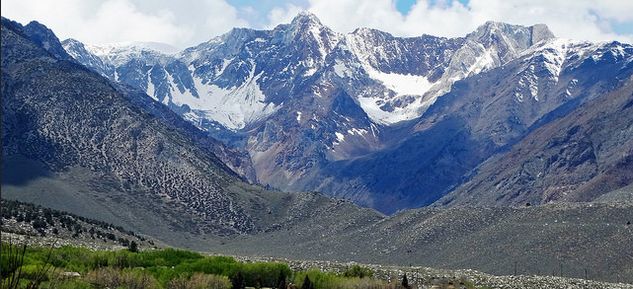Sierra Nevada seasonal snowpack lowest in the last 500 years

A new study, published in Nature Climate Change on September 14, 2015, shows the spring amount of snow on the Sierra mountains has sunk to its lowest levels in the last 500 years. The current circumstances of exceptional drought across the state of California thus represent a potential warning, as the mountain range is especially important for California's annual water supplies.
An official survey conducted in the Sierra on April 1, 2015 showed the snow levels throughout the mountain range were as low as 5% of the annual average since the 1950s. The snowpack of the mountain range can provide up to 30% of California's yearly water supplies. On the same day of the striking results the Governor of California issued an executive order mandating a 25% in potable urban water use statewide.
To determine the severity of those results, the scientists have used tree-ring measurements to reconstruct the annual spring snowpack across the mountains of Sierra Nevada over the last 500 years. According to the gathered historical data, this year's snow amount has reached its lowest record so far.

Snow loss on the Sierra Nevada mountain range between 2010 and 2015. Image credit: NASA/MODIS
“This is an interesting contribution that seems to fit very well with the emerging evidence that the current drought in California is exceptional” said Ben Cook, a climate scientist at the NASA Goddard Institute for Space Studies in New York City.
Valerie Trouet, a tree-ring scientist at the University of Arizona, explained the blue-oak trees (Quercus douglasii) in central California are especially good recorders of the past climate events as they are extremely sensitive to winter precipitation.
Trouet and her fellow researchers used the tree-ring data of 1 505 blue-oak trees from previous studies to conduct a research on a snowfall history of the Sierra mountain range.
Tree growth, reflected in the size of tree rings is determined by the factors such as the humidity and temperature of the environment. Combining the research results from the previous study, conducted to estimate annual temperatures in February and March across the western US, has allowed the scientists to estimate the amount of water contained in the historical spring snowpack.
The robust research of the Sierra snowpack is extremely important for residents of California, as it serves as the state's natural reservoir, Trouet explained. When extreme weather conditions combine, such as high temperatures and low precipitation the state experienced over the past winter, this reservoir vanishes.
Sources: Nature News, The Abstract of the paper – Nature Climate Change
Reference:
- "Multi-century evaluation of Sierra Nevada snowpack" – Soumaya Belmecheri, Flurin Babst, Eugene R. Wahl, David W. Stahle, Valerie Trouet – Nature Climate Change (2015) – doi:10.1038/nclimate2809
Featured image: Sierra Nevada, California, May 19, 2015. Image credit: Don Graham (CC-Flickr)

Glaciers advancing on Mt Baker, Washington, says renowned geologist